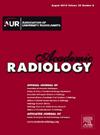Non-cardiovascular Calcification Measures and Warranty Period of a Zero CAC in Young Adults: the Multi-ethnic Study of Atherosclerosis
IF 3.9
2区 医学
Q1 RADIOLOGY, NUCLEAR MEDICINE & MEDICAL IMAGING
引用次数: 0
Abstract
Rationale and Objectives
This study investigates the warranty period for downstream incident coronary artery calcium (CAC) > 0 and cardiovascular disease (CVD) events in young adults (age < 50 years) with baseline CAC = 0, stratified by non-cardiovascular calcification. The absence of coronary calcification (CAC = 0) is a strong negative risk predictor, especially in young, low-risk individuals, as coronary events without CAC are rare. Beyond known cardiovascular risk factors, propensity for systemic calcium deposition—reflected by non-cardiovascular calcification—may influence incident CAC > 0. Refining risk prediction in young adults, who face cumulative harms from unnecessary imaging and radiation, is important.
Materials and Methods
Young adults with baseline CAC score = 0 from Exam 1 (2000–2002) of the MESA cohort (n = 402) were stratified by costal cartilage calcification (CCC) into below- and above-median groups (n = 201 each). A Weibull parametric survival model estimated time-to-conversion to CAC > 0 and CVD events, enabling estimation of the “warranty period” as the mean time to 25% incidence of CAC > 0% and 2% incidence of CVD events.
Results
By Exam 5 (2010–2012), incident CAC > 0 was observed in 27% of the below-median group and 42% of the above-median group. The warranty period for 25% CAC > 0 incidence was shorter in the above-median group (8.0 [95% CI: 7.2, 8.7] vs. 9.6 [8.6, 10.6] years). Conversely, the warranty period for 2% CVD incidence was longer in the above-median group (11.2 [95% CI: 7.4, 18.1] vs. 9.3 [95% CI: 6.5, 14.1] years).
Conclusion
In young adults with CAC = 0 at baseline, high non-cardiovascular calcification may indicate a shorter CAC > 0 incidence warranty period and possibly less severe atherosclerotic stages, as reflected by a longer warranty period for CVD events.
年轻人非心血管钙化措施和零CAC保修期:动脉粥样硬化的多民族研究。
基本原理和目的:本研究调查基线CAC=0的年轻成人(年龄< 50岁)下游事件冠状动脉钙化(CAC) bb0和心血管疾病(CVD)事件的质保期,按非心血管钙化分层。无冠状动脉钙化(CAC=0)是一个很强的负风险预测因子,特别是在年轻、低风险个体中,因为没有CAC的冠状动脉事件是罕见的。除了已知的心血管危险因素外,系统性钙沉积的倾向(由非心血管钙化反映)可能影响CAC的发生。完善年轻人的风险预测非常重要,因为他们面临着不必要的成像和辐射带来的累积伤害。材料和方法:MESA队列(n=402)中第一次考试(2000-2002)基线CAC评分为0的年轻人(n=402)根据肋软骨钙化(CCC)分为中位数以下组和中位数以上组(n=201)。Weibull参数生存模型估计了到CAC >和CVD事件的转换时间,从而可以估计“保证期”,即CAC >和CVD事件发生率分别为25%和2%。结果:到第5期(2010-2012),CAC >事件在中位数以下组中占27%,中位数以上组中占42%。中位数以上组25% CAC >发生率的保修期较短(8.0 [95% CI: 7.2, 8.7]对9.6[8.6,10.6]年)。相反,在中位数以上组中,2% CVD发生率的保修期更长(11.2年[95% CI: 7.4, 18.1] vs. 9.3年[95% CI: 6.5, 14.1]年)。结论:在基线时CAC=0的年轻人中,高的非心血管钙化可能表明CAC发病率保证期较短,并且可能较轻的动脉粥样硬化阶段,这反映在CVD事件的较长保证期上。
本文章由计算机程序翻译,如有差异,请以英文原文为准。
求助全文
约1分钟内获得全文
求助全文
来源期刊

Academic Radiology
医学-核医学
CiteScore
7.60
自引率
10.40%
发文量
432
审稿时长
18 days
期刊介绍:
Academic Radiology publishes original reports of clinical and laboratory investigations in diagnostic imaging, the diagnostic use of radioactive isotopes, computed tomography, positron emission tomography, magnetic resonance imaging, ultrasound, digital subtraction angiography, image-guided interventions and related techniques. It also includes brief technical reports describing original observations, techniques, and instrumental developments; state-of-the-art reports on clinical issues, new technology and other topics of current medical importance; meta-analyses; scientific studies and opinions on radiologic education; and letters to the Editor.
 求助内容:
求助内容: 应助结果提醒方式:
应助结果提醒方式:


